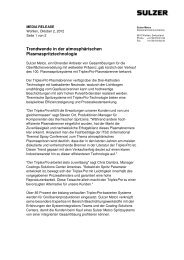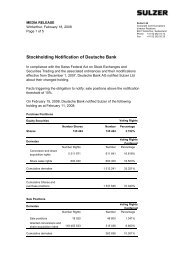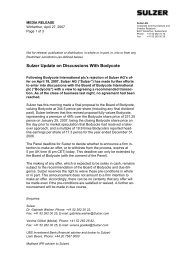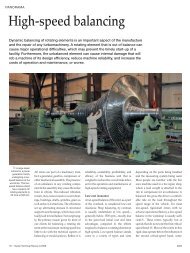Testing and quality
Testing and quality
Testing and quality
You also want an ePaper? Increase the reach of your titles
YUMPU automatically turns print PDFs into web optimized ePapers that Google loves.
SULZER ANALOGY<br />
<strong>Testing</strong> poisons<br />
In the plant world, there are numerous poisons, which,<br />
when consumed, can lead to serious problems or even<br />
death for human beings. People always have to try<br />
something out first in order to determine whether it is<br />
poisonous or not. So how do animals know which plants<br />
to beware of <strong>and</strong> which are beneficial?<br />
Structural formula of<br />
the alkaloid morphine,<br />
which Friedrich Wilhelm<br />
Sertürner extracted<br />
from the opium poppy<br />
in pure form in 1806.<br />
The struggle for survival in the natural<br />
world takes place not only between<br />
hunting lions <strong>and</strong> fleeing gazelles. Even<br />
the apparently peaceful coexistence<br />
between plants <strong>and</strong> animals is an incessant<br />
battle with the aim of surviving<br />
long enough to pass on one’s own genes<br />
to the next generation. As plants are<br />
unable to flee their predators, they have<br />
to defend themselves from the hungry<br />
mouths of animals in other ways. Spines,<br />
thorns, <strong>and</strong> bristly hairs offer mechanical<br />
protection. Unpleasant odors may also<br />
discourage consumption. The most effective<br />
defenses, however, are plant toxins<br />
that punish the “attacker” with physical<br />
problems or even death.<br />
It’s purely the dosage that makes<br />
the poison<br />
The plant world has developed an<br />
incredible wealth of chemical defenses.<br />
Tannins are very astringent. They cause<br />
the tongue to contract, dry out the<br />
mouth <strong>and</strong> throat, <strong>and</strong> disturb digestion.<br />
The greatest poison arsenal, however,<br />
are the alkaloids, which can be found<br />
© Smellme | Dreamstime.com<br />
in 20 percent of all flowering plants.<br />
Anyone who does not regard the<br />
bitter taste as a warning will have to<br />
experience on this own body how these<br />
nerve agents work.<br />
Humans also know about these<br />
poisons—from the atropine in the<br />
deadly nightshade <strong>and</strong> the quinine in<br />
cinchona bark to the nicotine in tobacco<br />
<strong>and</strong> the caffeine in coffee. Like almost<br />
any poison, alkaloids are digestible in<br />
small dosages, <strong>and</strong> they can have a<br />
stimulating or intoxicating effect. Both<br />
humans <strong>and</strong> animals have learned that<br />
low quantities of alkaloids only damage<br />
microbes <strong>and</strong> insects, <strong>and</strong> thereby<br />
provide the body with some protection<br />
against certain infections <strong>and</strong> pests.<br />
How do animals know what is poisonous?<br />
In order to avoid risks, the<br />
p<strong>and</strong>a bear restricts itself to harmless<br />
bamboo plants—with the disadvantage<br />
that it has to consume enormous quantities<br />
of this plant, which is low in nutrition.<br />
The rat has a very different strategy.<br />
It is an omnivore <strong>and</strong> has conquered the<br />
entire world thanks to its flexibility. As<br />
poisons lurk everywhere, the rat is very<br />
mistrustful of new things. If it finds an<br />
unfamiliar food source, it only eats a<br />
mini-portion at first. Only if it does<br />
not suffer any adverse reaction does it<br />
consume the new discovery in larger<br />
quantities. Moreover, if it sees that other<br />
rats are eating a new food without any<br />
Black howler monkey: Consumes unknown plant material only in small<br />
quantities in order to avoid a possible poisoning.<br />
problem, the rat knows that it can also<br />
eat the new food.<br />
Poison training course for rat<br />
embryos<br />
The poison training course for rats starts<br />
in the womb, where the embryo<br />
develops aversions to noxious smells<br />
<strong>and</strong> a preference for safe tastes. In<br />
mammals, young animals learn with<br />
their mother’s milk how good food<br />
smells <strong>and</strong> tastes. Moreover, when the<br />
baby animal takes its food from its<br />
mother’s mouth, this is not simply convenience,<br />
but vital training of the highest<br />
<strong>quality</strong>.<br />
Anyone who is mainly surrounded by<br />
poisonous leaves, such as the howler<br />
monkeys in the coastal forest of Costa<br />
Rica, has to come up with a particularly<br />
subtle feeding strategy. The more<br />
abundant a type of tree, the more is it<br />
avoided by the apes—because the only<br />
plants that can thrive are those that are<br />
inedible for herbivores. If a tree is judged<br />
acceptable, the animals seek out the<br />
youngest <strong>and</strong> smallest leaves—<strong>and</strong> if<br />
the plant nevertheless produces toxins,<br />
these would initially only be present in<br />
small amounts in fresh plant material.<br />
Furthermore, the howler monkeys only<br />
eat the stem of the leaf, thereby keeping<br />
to the part of the plant with the lowest<br />
toxic content.<br />
Herbert Cerutti<br />
4331 Sulzer Technical Review 1/2011 | 17

















